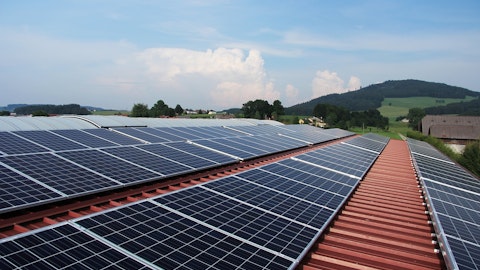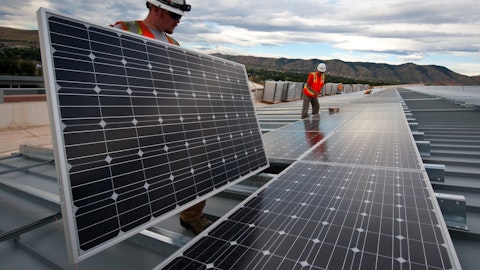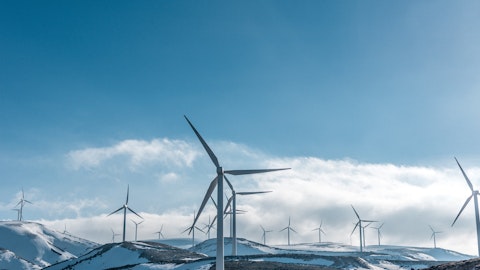Pavel Molchanov: The global financial crisis. I’m curious if you are observing the same level of savings in your input costs, modules, inverters, batteries. How is that shaping on both sides of the Atlantic?
Yumin Liu: I think I missed the first part of your question, but I understand your question really is about how the CapEx cut or decrease of the CapEx will impact our operation. Is that the case?
Pavel Molchanov: Yes, exactly right. Just thinking about the declines in equipment cost?
Yumin Liu: Okay, as we do have noticed that the CapEx is going down to the level about three, four years ago or even lower. The cost of our module price about 20%, 30% lower than three years ago. So that absolutely helped from our side as we are taking significantly EPC activities in Poland and Hungary right now. As the — based on our original forecast, we are looking at a module price at least 20% higher than what we pay today. This is very good. Another one is that we do see on global basis, the oversupply of old supply chain is helping us not only cutting the CapEx, but also solidify the expectation from the investors. As we see the value of our product pipeline with the core of our company is going up as of the lower CapEx. Well, as I mentioned earlier, answering Phil’s question, not only in Europe, but also U.S., we see the offtake power price is higher even than three, four years ago.
That gave us the confidence that our valuation of the portfolio is not only there, but also is going up. The key now is for us, not only the management and the whole team of Emeren is to execute and continue our development activities across the board.
Ke Chen: Pavel, I just want to add we are very strong in Poland and the Hungary market. If you look at the merchant price of those two countries today, they’re still over EUR100 per megawatt hour. So it’s very favorable for us to do party development in those countries.
Pavel Molchanov: That’s helpful. Let me also ask about your IPP activities. Over the past year, you’ve kind of clearly diversified your IPP footprint away from China $9 million quarterly revenue in both of the past two quarters. Should we look at that as a steady state for 2024 or will you continue to add assets into your IPP asset base?
Ke Chen: Yes the — our IPP strategy, although we call that light IPP strategy, literally allows us to gain this stable level cash flow. From our IPP projects, across the board, close to about 240 megawatts. And on top of that, if you look at the revenue or the profit from our assets, I will say our IPP only stands for about 30% to 40% of the total. while our NTP and our RTB product sale represent a major portion of our revenue expectation. That’s another 40 some percent. And one signing part of the company really goes to storage, which we believe starting 2024, our revenue and income, conservatively 15% to 20% will come from storage, and that one will continue to grow significantly. Hopefully, it can be doubled in ’25 or continue going up in the following years.
Pavel Molchanov: Got it. Electricity prices have obviously come down substantially in Europe since the PPAs that you were signing 12-months ago. If you were to sign incremental PPAs in places like Poland or Germany over the next several months, would those be attractive economics from a multiyear standpoint?
Yumin Liu: It is a balanced act that from financing perspective we like to sign up long-term PPAs. But long-term PPA price is not very attractive to us at this time. Short-term PPA price, one to two year PPA price is still pretty high. As Ke just mentioned that across the board in Europe, we see around EUR100 per megawatt hours, okay. That is a very attractive price, which is about 20% to 30% higher, compared to three to four years ago. And if we want to sign up in the countries, as you mentioned, or in the countries we are active pursuing projects or IPP assets, I’m looking at higher than $100 per megawatt hours. That is what I’m talking about, as high as EUR100, EUR120, EUR130 if I want to sign one to two year contract. But at this time, we don’t have any concern on that front as we are combining our operating profile from not only the NTP, RTB sale, but also our light IPP strategy.
So going forward, we’ll combine a shorter-term IPP PPA strategy combined with an expectation of a long term in terms of helping on the financing side.
Ke Chen: Pavel, just a reminder, our Branston project in U.K., we have signed four years PPA over GBP150 PPA price. So at this point, we don’t need to looking for any short-term PPA right now.
Pavel Molchanov: Alright. Thanks very much.
Yumin Liu: Thank you, Pavel.
Operator: Thank you. Our next question comes from Donovan Schafer from Northland Capital Markets. Please go ahead.
Donovan Schafer: Hey, guys. Thanks for taking the question. I first want to ask about the sale of the five battery storage projects to Matrix this quarter. Since in the release and the letter to shareholders today, you talk about how the RTB status of these projects has not been achieved and it’s not expected until late 2024, so it’s not NTP, not RTB at the time of the sale, but a point of sale much before that. So I was just wondering what kind of pricing do you get when it’s a sale this early in the process. I think we’ve talked about $0.10 to $0.20 RTB. So if you’re selling now, is this $0.05 a watt? Something less than that? Just trying to get my understanding here.
Yumin Liu: You know, Donovan, that I cannot really release the number for the sale, but it is in the structure of typical so called government Development Service Agreement, and we have the contract with Matrix. We are onboarding up to 1.5 gigawatt, not gigawatt hours, of projects within next, I would say, 12 to 18 months, and we have onboarded almost half of that portfolio. And that is the two announcements, as we talk about cumulative of 3.8 gigawatt hours, okay? We are continuing developing those projects all the way based on the milestones, achieving the final RTB status by late 2024, while in the process, for the next 12 months or so, we will be expecting milestone payments with the progress of the development of the projects.




